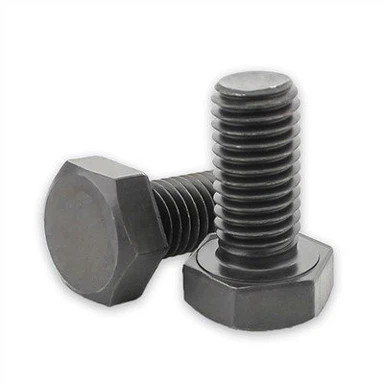Detailed Technical Explanation Of Electrogalvanized Bolt Surface Treatment
Apr 09, 2025
In the fastener industry, 4.8-grade hex bolts are among the most widely used standard components. Besides natural passivation, electrogalvanizing (cold galvanizing) and hot-dip galvanizing are the two mainstream surface treatment processes for these bolts. Hexagon socket head cap screws, in particular, rely heavily on electrogalvanizing due to their precision structure and hidden assembly requirements. This process enhances corrosion resistance and aesthetic appeal: the electrochemically deposited zinc coating can extend the salt spray life of steel substrates from less than 24 hours in their bare state to 50–100 hours (depending on the coating process), while achieving diverse surface finishes such as silver, blue-white, and rainbow zinc.

I. Principles and Core Characteristics of Electrogalvanizing
Electrogalvanizing is a cathodic electrochemical deposition process with the following core principles:
Cathode (Workpiece): The bolt acts as the cathode connected to the negative terminal of a DC power supply. A reduction reaction occurs on its surface, where zinc ions are reduced to metallic zinc and deposited (reaction formula: Zn²⁺ + 2e⁻ → Zn).
Anode (Soluble Electrode): A zinc plate serves as the anode connected to the positive terminal. An oxidation reaction dissolves the zinc plate, replenishing zinc ions in the electrolyte (reaction formula: Zn - 2e⁻ → Zn²⁺).
Electrolyte System: Composed primarily of zinc salts (e.g., ZnCl₂, ZnSO₄), with conductive salts, brighteners (e.g., benzylidene acetone derivatives), and pH buffers to ensure stable migration and uniform deposition of zinc ions.
The fundamental differences from hot-dip galvanizing are as follows:
| Process Parameter | Electrogalvanizing (Cold Galvanizing) | Hot-Dip Galvanizing |
|---|---|---|
| Treatment Temperature | Ambient (20–50℃) | High-temperature (450–480℃) |
| Coating Formation Mechanism | Electrochemical deposition | Metallurgical diffusion |
| Coating Thickness | 5–15μm | 50–80μm (for steel) |
| Surface Roughness | Ra≤0.2μm (bright coating) | Ra≥1.0μm (rough coating) |
| Suitable Parts | Precision/complex components | Large structural parts |
II. Standardized Treatment Process
1. Pretreatment (Critical for Coating Quality)
Degreasing: Ultrasonic cleaning with alkaline degreasing agents (NaOH + surfactants) removes mineral oil and cutting fluid residues, preventing oil contamination from hindering zinc ion adsorption.
Pickling Activation (Necessary for Medium-High Carbon Steel):
8.8-grade bolts (medium carbon steel) are immersed in 15–20% hydrochloric acid solution (50–60℃) to dissolve iron oxide scale (Fe₃O₄), following the reaction: Fe₃O₄ + 8HCl → 2FeCl₃ + FeCl₂ + 4H₂O. After pickling, they are neutralized with 5% sodium carbonate solution and rinsed three times with countercurrent water until neutral (pH=6.5–7.5).
Mild Etching: A 5% dilute sulfuric acid dip (3–5 seconds) removes the surface passivation film just before plating, ensuring an active substrate.
2. Electrogalvanizing Deposition
Bath Parameters: Current density 1–3A/dm² (excessive current causes burning, insufficient current leads to porous coatings), temperature 25–35℃, pH 4.5–5.5 (acidic environment suppresses hydrogen evolution). Plating time is controlled by an ampere-hour meter based on the target thickness (e.g., 30 minutes for 8μm).
Coating Properties: The zinc layer is uniform and dense, capable of covering micro-defects like shallow scratches, but cannot repair deep dents or rust pits (mechanical grinding is required beforehand).
3. Post-Treatment Enhancement
Passivation Processes:
Blue-White Passivation (Trivalent Chromium): Salt spray test 48–72 hours, blue-white glossy finish, environmentally friendly.
Rainbow Passivation (Hexavalent Chromium, phasing out): Salt spray test >100 hours, multicolored finish, superior corrosion resistance.
Chromium-Free Passivation (Titanium/Molybdate): Salt spray test 36–48 hours, silver-white finish, compliant with RoHS standards.
Sealing Treatment: Water-soluble sealants are applied to threads to fill coating pores, improving resistance to moisture and humidity (especially for electronic devices).
III. Comparison with Other Surface Treatment Processes
| Process | Applicable Material | Coating Type | Thickness | Salt Spray Test | Typical Applications |
|---|---|---|---|---|---|
| Electrogalvanizing | Steel parts | Metallic zinc coating | 5–15μm | 48–100 hours | Precision bolts, electronic components |
| Hot-Dip Galvanizing | Steel parts | Zinc-iron alloy coating | 50–80μm | >500 hours | Outdoor steel structures, bridge bolts |
| Anodic Oxidation | Aluminum/Aluminum alloys | Aluminum oxide film | 5–25μm | 200–500 hours | Aluminum fasteners, aerospace parts |
| Dacromet | Steel/aluminum-based alloys | Chromium-free zinc-based coating | 6–8μm | >1000 hours | High-corrosion resistance automotive bolts |
Note: Anodic oxidation is exclusive to aluminum and its alloys, forming a porous Al₂O₃ film through electrolysis-fundamentally different from the principles of electrogalvanizing.
IV. Industrial Applications and Quality Control
1. Application Scenarios
Ideal Use Cases: General atmospheric environments (humidity <85%RH), indoor assembly, and scenarios requiring high appearance and torque precision (e.g., furniture, electronics, automotive interior parts).
Limitations: Unsuitable for high-salt spray (marine environments), strong acid/alkali, long-term immersion, or ultra-high-strength conditions (hot-dip galvanizing or Dacromet is preferred).
2. Testing Standards
Coating Thickness: Measured by X-ray fluorescence spectroscopy (XRF), compliant with GB/T 9799-2011 Metallic and Other Inorganic Coatings - Electrogalvanized Coatings on Steel.
Adhesion: Tested via CASS (Copper Accelerated Acetic Acid Salt Spray) according to ISO 2819; no blistering or peeling of the coating is allowed.
Appearance: Visual inspection under 6000K standard light; slight uniform color difference is acceptable, but missing coating, black spots, or dendritic crystals are prohibited.
3. Failure Warnings
Hydrogen Embrittlement Risk: For substrates harder than 32HRC, a 4-hour dehydrogenation treatment at 200℃ is required after plating to prevent stress-induced fracture.
Environmental Adaptation: In high-humidity sulfur-containing environments (e.g., industrial atmospheres), zinc-nickel alloy coatings are recommended, offering 3x improved corrosion resistance.
V. Technical Summary
Electrogalvanizing is the preferred surface treatment for mid-to-low-end fasteners, accounting for over 70% of the market, due to its ambient-temperature operation, low cost (approximately 1/3 of hot-dip galvanizing), and controllable appearance. Its core advantages lie in coating uniformity and maintenance of assembly precision, making it suitable for scenarios requiring moderate corrosion resistance and aesthetic appeal. By strictly controlling pretreatment activation, electrolyte composition, and passivation film density, high-quality mass production can be achieved, meeting international and domestic standards such as GB/T and ISO.






